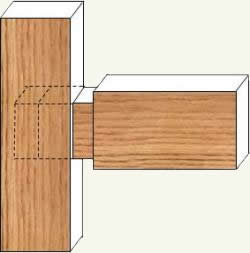- Mortise & Tenon Joint: Figure 4

Figure 4 - Mortise & tenon joint

Figure 5 - Mortising chisel and bit
- Tongue & Groove Joint: Figure 6
A mortise and tenon joint is made by removing an amount of wood from one end of the piece of lumber and making a mortise (square of rectangular hole) in the mating piece of lumber so that the tenon created at the end of the first board fits tightly into the mortise of the second board.
The tenon should be a tight fit into the mortise and in many cases a mallet is needed in order to seat the tenon all the way into the mortise.
Mortise and tenon joints are generally not used at the ends of both boards, but rather when joining one board in the middle of another. However, there is no reason why the mortise and tenon style joint could not be used at the ends as well.
A mortise and tenon joint is quite strong as there is a lot of surface area to hold adhesive.
The mortise and tenon joints can be made with a hand drill, wood chisels and a backsaw. However, the use of a mortising and chisel bit, as shown in Figure 5, in a drill press and either a dado blade in a table saw or a router mounted in a router table will make the project much easier.
The mortise and tenon joint is an excellent joint for many woodworking projects. It is an excellent choice on fences, where the mortises are placed in the vertical post and the tenons are on the ends of the horizontal cross members. The use of mortise and tenon joints on fences alleviates the need to use metal brackets.

Figure 6 - Tongue and groove joint
The tongue and grove joint is popular for hardwood flooring, wainscoting and plywood where the length of one board is attached to the length of another board on the edges.
The tongue and grove joint is generally not something that the home handyman would use unless doing a project such as a patterned hardwood floor.
A tongue and grove joint is used primarily to keep adjacent boards level rather than as a method of fastening boards together.
The joint does not generally have glue applied, but instead each board is fastened into position using screws, nails or adhesive individually.
Because the tongue and grooves are made on the edges of the boards the best tool to create the joint is a router mounted in a router table or a dado blade on a table saw. Hand tools are not appropriate for making tongue and groove joints.
In many cases it is necessary to use a mallet to seat the tongue all the way into the groove.
